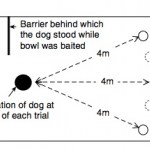dog
Image: LA Times
Recent research has shown that dogs may offer protection from respiratory syncytial virus (RSV), a common virus in infants associated with high risks for the development of asthma. Mice fed dust from homes with dogs prior to exposure to RSV showed immunity to the virus when compared to mice fed dust from dog-free homes. Moreover, the dog-exposed mice had “a distinct gastrointestinal bacterial composition,” that may lend to this immunity. The researchers are now planning on identifying the microbes responsible for this immune protection in the hope of developing a vaccine.…
"Are we to paint what's on the face, what's inside the face, or what's behind it?" -Pablo Picasso
As an animal lover, like others here on scienceblogs, as well as a big fan of Halloween costumes, it's probably unsurprising that a good, creative animal costume will crack me up.
Three more turtle dogs and a giant rat will complete the set!
Turn your sweet, harmless puppy into the fearsome guardian of Hades by adding two extra heads!
Sometimes, you just need to play to your strengths. In this case, it's ridiculous cuteness.
Dressing animals like other animals is practically its own…
The blog is recovering from the transition to WordPress, but I'm still not fully confident in it. So We'll turn to another corner of the social media universe for my procrastinatory needs this morning: Having Emmy answer physics questions on Twitter.
The same deal as when we've done this before: If you've got a physics question you'd like my dog to answer, post it to Twitter with the hashtag #dogphysics (or leave it in a comment, or email it to me), and Emmy will answer via Twitter, where she's @queen_emmy.
You've probably had a conversation that goes something like this:
Person A: "My dog is sooooo amazing!"
You: "I mean, dogs are awesome and all, but what's so amazing about this particular dog?"
Person A: "He just understands me. It's like he knows what I'm thinking and what I need."
You: "Do you think he's just maybe responding contingently do your overt displays of emotion?"
Person A: "Listen, man, I'm telling you: my dog can read my mind!"
No matter on which side of this sort of argument you tend to fall, the question of whether or not domestic dogs can read human minds is an interesting…
Welcome to Territoriality Week! Every day this week, I'll have a post about some aspect of animal or human territoriality. How do animals mark and control their territories? What determines the size or shape of an animal's territory? What can an animal's territory tell us about neuroanatomy? Today, I begin by asking two questions: first, what is the functional purpose of establishing territories? Second, to what extent can we apply findings from research on animal territorial behavior to understanding human territorial behavior?
It seems that everyone becomes an amateur animal behaviorist…
Lots of animals are well aware that bigger means scarier. In stressful or aggressive situations, for example, the hair or fur of chimpanzees, rats, cats, and even humans stands up on end (in humans, given our lack of fur, this results in goose bumps) in an effort to dissuade a potential attack. Elephant seals use a display called "rearing up" to make themselves look bigger - as if they need to look bigger in the first place!
Since some animals tend to be good at looking bigger than they truly are, visual cues may not actually be a reliable method of sizing up another individual. In addition…
There is a small bit of land, only about a square kilometer, that has added a new wrinkle to the story of animal domestication. This bit of land located in Northern Jordan, just southeast of the Sea of Galilee near the banks of the Jordan River, is home to an archaeological site known as 'Uyun al-Hammam. One key feature of this site, excavated in 2005, is a burial ground containing the remains of at least eleven humans in eight different gravesites. The early humans were buried here sometime during the pre-Natufian period, or around 16,500 years ago.
Layout of the 'Uyun al-Hammam site, and…
Most dog owners think that their dogs can tell what they're thinking. Or at least, in some sense, they will insist that their pet pooches can sense their emotions, and respond accordingly.
Indeed, a man by the name of Karl Krall (say that three times fast) thought that there exist some sort of psychic connections between man and animal. And he thought he could prove it.
In this telepathy experiment between human and dog Karl Krall (on the right) tried to detect the thinking radiation he assumed to flow between the two. Krall was a rich dealer in diamonds who had founded his very own…
If this doesn't tug on the heartstrings, at least a little bit, you may not be quite human.
As with yesterday's post, I don't know where this came from or who wrote it. If you do, please let me know so I can properly attribute it. It is again, a very "tall" image, so I've placed it behind the fold.
Click to enlarge.
I'm not sure where this is from, or who made it (if you do, though, please let me know so I can give it proper attribution). But I think its hilarious and awesome. The image is particularly large, though, so I've placed it behind the fold.
Click to enlarge:
Eric M. Johnson and I spent about 45 minutes discussing "evolutionary psychology beyond sex" last night, which you can see today on Bloggingheads "Science Saturday."
Or just watch it here:
"Two chimps had been shut out of their shelter by mistake during a cold rain storm. They were standing dejeted, water streaming down their shivering bodies, when Professor Köhler chanced to pass." Upon opening the door for the two chimps, Dr. James Leuba recounts, "instead of scampering in without more ado, as many a child would have done, each of them delayed entering the warm shelter long enough to throw its arms around his benefactor in a frenzy of satisfaction."
"Chimpanzees," primatologist Frans de Waal points out, "do not normally hug their caretakers for no reason." It's a compelling…
In March 2000, Dr. Simon Chapman and colleagues from the University of Sydney published a paper in which they assessed the effectiveness of an educational intervention for the prevention of dog bites in children.
"Prevent-a-Bite" is an educational programme designed for primary school children. The programme aims to instill precautionary behaviour around dogs, assuming that this might reduce the incidence of attacks. A randomised controlled trial of the efficacy of the intervention was conducted in Australian children aged 7-8 years who were presented with an unsupervised opportunity to…
Does Fido see the cup as half full? Is your dog pessimistic? Last time we saw headlines like these they were about a certain barnyard animal. Remember "Pampered pigs 'feel optimistic'"? I didn't like it then, and I don't like it now.
Roughly half of the population of dogs in the UK are likely to - at some point in their lives - exhibit "undesirable separation-related behavior (SRB)." These are things that sometimes happen when left alone, like barking, chewing up or otherwise destroying objects, and urinating (or worse!) inside the house. While some owners view these behaviors as fine and…
This one is worth watching all the way through:
(h/t Sara)
And, from the sublime to the mundane:
(h/t Dr. Kiki)
I showed this video today as an intro to my 8-week "mini-course" on Canine Cognition.
In it, narrator John Lithgow presents two slightly different versions of the dog domestication story. The first version is essentially the Belyaev story: young wolves would be adopted into the camps of early humans. Only those who were most tame would breed with eachother, and over many generations, the domestic dog would emerge. The second is the version in which wolves "chose" to be domesticated - they noticed a lot of tasty trash around human encampments, and if they were unafraid enough to hang around,…
Your humble narrator finds himself sick with a cold, so here's a post from the archives.
There is considerable research on how children interact with other children and with adults, and how child development can be influenced by those interactions. But research on children's interactions with non-human animals seem to be limited. Given how ubiquitous pets are in the homes of children (at least, in WEIRD cultures), it is somewhat surprising that there hasn't been more work on the way pet ownership might affect child development.
According to the US Humane Society:
There are approximately 77…
Cooperation and conflict are both a part of human society. While a good deal of the academic literature addresses the evolutionary origins of conflict, in recent years there has been an increased focus on the investigation of the evolutionary origins of cooperative behavior. One component of cooperative behavior that might be present in other animals is aversion to inequity. Some scientists have suggested that inequity aversion may itself be the main factor driving the enforcement of cooperation. Put simply, inequity aversion is the resistance among partners to unequal rewards following…
At least one dog can be found in forty percent of US households, and forty percent of those owners allow their dogs to sleep on their beds. To put this in perspective, in a family with five children, two of them can be expected to become dog owners, and one of them will probably allow the dog to sleep on his or her bed. In an undergraduate lecture class of two hundred, eighty of those students come from homes with at least one pet dog. So as you might expect, dogs are a big business! In 2007, the pet industry was worth about $40 billion in the US, with dogs responsible for the largest share…
Dogs are pretty smart. They can have huge vocabularies, they can infer meaning in the growls of other dogs, and they can effortlessly figure out if other dogs want to play or fight with them. But their intelligence might be limited to the social domain; indeed, while they outperform chimpanzees in social tasks, chimpanzees outperform them in many other tasks. And they might have developed their impressive social skills as merely an accident of natural and artificial selection.
Previous research has shown that dogs can use lots of different forms of human communicative signals to find food,…

















